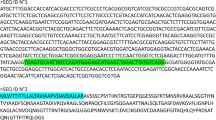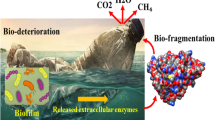Abstract
We used biodegradable plastics as fermentation substrates for the filamentous fungus Aspergillus oryzae. This fungus could grow under culture conditions that contained emulsified poly-(butylene succinate) (PBS) and emulsified poly-(butylene succinate-co-adipate) (PBSA) as the sole carbon source, and could digest PBS and PBSA, as indicated by clearing of the culture supernatant. We purified the PBS-degrading enzyme from the culture supernatant, and its molecular mass was determined as 21.6 kDa. The enzyme was identified as cutinase based on internal amino acid sequences. Specific activities against PBS, PBSA and poly-(lactic acid) (PLA) were determined as 0.42 U/mg, 11 U/mg and 0.067 U/mg, respectively. To obtain a better understanding of how the enzyme recognizes and hydrolyzes PBS/PBSA, we investigated the environment of the catalytic pocket, which is divided into carboxylic acid and alcohol recognition sites. The affinities for different substrates depended on the carbon chain length of the carboxylic acid in the substrate. Competitive inhibition modes were exhibited by carboxylic acids and alcohols that consisted of C4-C6 and C3-C8 chain lengths, respectively. Determination of the affinities for different chemicals indicated that the most preferred substrate for the enzyme would consist of butyric acid and n-hexanol.






Similar content being viewed by others
References
Ando Y, Yoshikawa K, Yoshikawa T, Nishioka M, Ishioka R, Yakabe Y (1998) Biodegradability of poly (tetramethylene succinate-co-tetramethylene adipate). I. Enzymatic hydrolysis. Polym Degrad Stabil 61:129–137
Barbesgaard P, Heldt-Hansen HP, Diderichsen B (1992) On the safety of Aspergillus oryzae: a review. Appl Microbiol Biotechnol 36:569–572
Christensen T, Woeldike H, Boel E, Mortensen SB, Hjortshoejk K, Thim L, Hansen MT (1988) High-level expression of recombinant genes in Aspergillus oryzae. Biotechnology 6:1419–1422
Cleland WW (1979) Substrate inhibition. Methods Enzymol 63:500–513
Coligan JE, Krusbeek AM, Margulies DH, Shevach EM, Strober W (1991) Current protocols in immunology. Greene/Wiley, New York
Egmond MR, de Vlieg J (2000) Fusarium solani pisi cutinase. Biochimie 82:1015–1021
Ferreira BS, Calado CR, van Keulen F, Fonseca LP, Cabral JM, da Fonseca MM (2003) Towards a cost effective strategy for cutinase production by a recombinant Saccharomyces cerevisiae: strain physiological aspects. Appl Microbiol Biotechnol 61:69–76
Fromm HJ (1979) Use of competitive inhibitors to study substrate binding order. Methods Enzymol 63:467–486
Fujimaki T (1998) Processability and properties of aliphatic polyesters, ‘BIONOLLE’, synthesized by polycondensation reaction. Polym Degrad Stabil 59:209–214
Gouka RJ, Punt PJ, van den Hondel CA (1997) Efficient production of secreted proteins by Aspergillus: progress, limitations and prospects. Appl Microbiol Biotechnol 47:1-11
Hatamoto O, Sekine H, Nakano E, Abe K (1999) Cloning and expression of a cDNA encoding the laccase from Schizophyllum commune. Biosci Biotechnol Biochem 63:58–64
Hawthorne BT, Rees-George J, Crowhurst RN (2001) Induction of cutinolytic esterase activity during saprophytic growth of cucurbit pathogens, Fusarium solani fsp. cucurbitae races one and two (Nectria haematococca MPI and MPV, respectively). FEMS Microbiol Lett 194:135–141
Hirano H, Watanabe T (1990) Microsequencing of proteins electrotransferred onto immobilizing matrices from polyacrylamide gel electrophoresis: application to an insoluble protein. Electrophoresis 11:573–580
Huang SJ (1995) Polymer waste management-biodegradation, incineration, and recycling. J Macromol Sci Pure A 32:593–597
Ishigaki T, Sugano W, Ike M, Kawagoshi Y, Fukunaga I, Fujita M (2000) Abundance of polymers degrading microorganisms in a sea based solid waste disposal site. J Basic Microbiol 40:177–186
Kitakuni E, Yoshikawa K, Nakano K, Sasuga J, Nobiki M, Naoi H, Yokota Y, Ishioka R, Yakabe Y (2001) Biodegradation of poly (tetramethylene succinate-co-tetramethylene adipate) and poly (tetramethylene succinate) through water-soluble products. Environ Toxicol Chem 20:941–946
Kleeberg I, Hetz C, Kroppenstedt RM, Muller RJ, Deckwer WD (1998) Biodegradation of aliphatic-aromatic copolyesters by Thermomonospora fusca and other thermophilic compost isolates. Appl Environ Microbiol 64:1731–1735
Kolattukudy PE (1984) Detection of an N-terminal glucuronamide linkage in proteins. Methods Enzymol 106:210–217
Kolattukudy PE, Rogers LM, Li D, Hwang CS, Flaishman MA (1995) Surface signaling in pathogenesis. Proc Natl Acad Sci USA 92:4080–4087
Laemmli UK (1970) Cleavage of structural proteins during the assembly of the head of bacteriophage T4. Nature 227:680–685
Lin TS, Kolattukudy PE (1977) Glucuronyl glycine, a novel N-terminus in a glycoprotein. Biochem Biophys Res Commun 75:87–93
Lin TS, Kolattukudy PE (1980) Structural studies on cutinase, a glycoprotein containing novel amino acids and glucuronic acid amide at the N terminus. Eur J Biochem 106:341–351
Longhi S, Czjzek M, Lamzin V, Nicolas A, Cambillau C (1997a) Atomic resolution (1.0 Å) crystal structure of Fusarium solani cutinase: stereochemical analysis. J Mol Biol 268:779–799
Longhi S, Mannesse M, Verheij HM, De Haas GH, Egmond M, Knoops-Mouthuy E, Cambillau C (1997b) Crystal structure of cutinase covalently inhibited by a triglyceride analogue. Protein Sci 6:275–286
Lowry OH, Rosebrough NJ, Farr AL, Randall RJ (1951) Protein measurement with the Folin phenol reagent. J Biol Chem 193:265–275
Machida M (2002) Progress of Aspergillus oryzae genomics. Adv Appl Microbiol 51:81–106
Maeda H, Sano M, Maruyama Y, Tanno T, Akao T, Totsuka Y, Endo M, Sakurada R, Yamagata Y, Machida M, Akita O, Hasegawa F, Abe K, Gomi K, Nakajima T, Iguchi Y (2004) Transcriptional analysis of genes for energy catabolism and hydrolytic enzymes in the filamentous fungus Aspergillus oryzae using cDNA microarrays and expressed sequence tags. Appl Microbiol Biotechnol 65:74–83
Mannesse ML, Cox RC, Koops BC, Verheij HM, de Haas GH, Egmond MR, van der Hijden HT, de Vlieg J (1995) Cutinase from Fusarium solani pisi hydrolyzing triglyceride analogues. Effect of acyl chain length and position in the substrate molecule on activity and enantioselectivity. Biochemistry 34:6400–6407
Martinez C, De Geus P, Lauwereys M, Matthyssens G, Cambillau C (1992) Fusarium solani cutinase is a lipolytic enzyme with a catalytic serine accessible to solvent. Nature 356:615–618
Matsudaira P (1987) Sequence from picomole quantities of proteins electroblotted onto polyvinylidene difluoride membranes. J Biol Chem 262:10035–10038
Mayer JM, Kaplin DL (1994) Biodegradable materials: balancing degradability and performance. Trends Polym Sci 2:227–235
Murphy CA, Cameron JA, Huang SJ, Vinopal RT (1996) Fusarium polycaprolactone depolymerase is cutinase. Appl Environ Microbiol 62:456–460
Nakamura K, Tomita T, Abe N, Kamio Y (2001) Purification and characterization of an extracellular poly(l-lactic acid) depolymerase from a soil isolate, Amycolatopsis sp. strain K104-1. Appl Environ Microbiol 67:345–353
Ohnishi K, Yoshida Y, Sekiguchi J (1994) Lipase production of Aspergillus oryzae. J Ferment Bioeng 77:490–495
Ohnishi K, Yoshida Y, Toida J, Sekiguchi J (1994) Purification and characterization of a novel lipolytic enzyme from Aspergillus oryzae. J Ferment Bioeng 78:413–419
Ohnishi K, Toida J, Nakazawa H, Sekiguchi J (1995) Genome structure and nucleotide sequence of a lipolytic enzyme gene of Aspergillus oryzae. FEMS Microbiol Lett 126:145–150
Potts J, Clendinning R, Ackart WB, Niegisch WD (1973) The biodegradability of synthetic polymers. In: Guillet J (eds) Polymers and ecological problems. Plenum, New York, pp 61–79
Prompers JJ, van Noorloos B, Mannesse ML, Groenewegen A, Egmond MR, Verheij HM, Hilbers CW, Pepermans HA (1999) NMR studies of Fusarium solani pisi cutinase in complex with phosphonate inhibitors. Biochemistry 38:5982–5994
Purdy RE, Kolattukudy PE (1975a) Hydrolysis of plant cuticle by plant pathogens. Properties of cutinase I, cutinase II, and a nonspecific esterase isolated from Fusarium solani pisi. Biochemistry 14:2832–2840
Purdy RE, Kolattukudy PE (1975b) Hydrolysis of plant cuticle by plant pathogens. Purification, amino acid composition, and molecular weight of two isozymes of cutinase and a nonspecific esterase from Fusarium solani f. pisi. Biochemistry 14:2824–2831
Rudolph FB (1979) Product inhibition and abortive complex formation. Methods Enzymol 63:411–436
Rudolph FB, Fromm HJ (1979) Plotting methods for analyzing enzyme rate data. Methods Enzymol 63:138–159
Saito K, Miura N, Yamazaki M, Hirano H, Murakoshi I (1992) Molecular cloning and bacterial expression of cDNA encoding a plant cysteine synthase. Proc Natl Acad Sci USA 89:8078–8082
Schafer W (1993) The role of cutinase in fungal pathogenicity. Trends Microbiol 1:69–71
Schagger H, von Jagow G (1987) Tricine-sodium dodecyl sulfate-polyacrylamide gel electrophoresis for the separation of proteins in the range from 1 to 100 kDa. Anal Biochem 166:368–379
Shibuya I, Tsuchiya K, Tamura G, Ishikawa T, Hara S (1992) Overproduction of an alpha-amylase/glucoamylase fusion protein in Aspergillus oryzae using a high expression vector. Biosci Biotechnol Biochem 56:1674–1675
Suyama T, Hosoya H, Tokiwa Y (1998a) Bacterial isolates degrading aliphatic polycarbonates. FEMS Microbiol Lett 161:255–261
Suyama T, Tokiwa Y, Ouichanpagdee P, Kanagawa T, Kamagata Y (1998b) Phylogenetic affiliation of soil bacteria that degrade aliphatic polyesters available commercially as biodegradable plastics. Appl Environ Microbiol 64:5008–5011
Sweigard JA, Chumley FG, Valent B (1992a) Cloning and analysis of CUT1, a cutinase gene from Magnaporthe grisea. Mol Gen Genet 232:174–182
Sweigard JA, Chumley FG, Valent B (1992b) Disruption of a Magnaporthe grisea cutinase gene. Mol Gen Genet 232:183–190
Takahashi T, Chang PK, Matsushima K, Yu J, Abe K, Bhatnagar D, Cleveland TE, Koyama Y (2002) Nonfunctionality of Aspergillus sojae aflR in a strain of Aspergillus parasiticus with a disrupted aflR gene. Appl Environ Microbiol 68:3737–3743
Teeraphatpornchai T, Nakajima-Kambe T, Shigeno-Akutsu Y, Nakayama M, Nomura N, Nakahara T, Uchiyama H (2003) Isolation and characterization of a bacterium that degrades various polyester-based biodegradable plastics. Biotechnol Lett 25:23–28
Tsuchiya K, Nagashima T, Yamamoto Y, Gomi K, Kitamoto K, Kumagai C, Tamura G (1994) High level secretion of calf chymosin using a glucoamylase-prochymosin fusion gene in Aspergillus oryzae. Biosci Biotechnol Biochem 58:895–899
Tsuchiya K, Tada S, Gomi K, Kitamoto K, Kumagai C, Jigami Y, Tamura G (1992) High level expression of the synthetic human lysozyme gene in Aspergillus oryzae. Appl Microbiol Biotechnol 38:109–114
Uchida H, Nakajima-Kambe T, Shigeno-Akutsu Y, Nomura N, Tokiwa Y, Nakahara T (2000) Properties of a bacterium which degrades solid poly (tetramethylene succinate)-co-adipate, a biodegradable plastic. FEMS Microbiol Lett 189:25–29
Yu J, Proctor RH, Brown DW, Abe K, Gomi K, Machida M, Hasegawa F, Nierman WC, Bhatnagar D, Cleveland TE (2004). Genomics of economically significant Aspergillus and Fusarium species. In: Arora KD, Khachatourians GG (eds) Applied mycology and biotechnology, vol 4. Fungal genomics. Elsevier, Amsterdam
Acknowledgements
This work has been supported by Innovation Plaza Miyagi of JST (Japan Science and Technology Agency), and was supported in part by a grant-in-aid (Bio Design Program) from the Ministry of Agriculture, Forestry and Fisheries of Japan (BDP-03-VI-1-6)
Author information
Authors and Affiliations
Corresponding author
Rights and permissions
About this article
Cite this article
Maeda, H., Yamagata, Y., Abe, K. et al. Purification and characterization of a biodegradable plastic-degrading enzyme from Aspergillus oryzae . Appl Microbiol Biotechnol 67, 778–788 (2005). https://doi.org/10.1007/s00253-004-1853-6
Received:
Revised:
Accepted:
Published:
Issue Date:
DOI: https://doi.org/10.1007/s00253-004-1853-6




